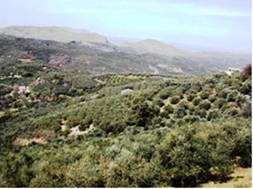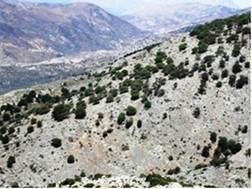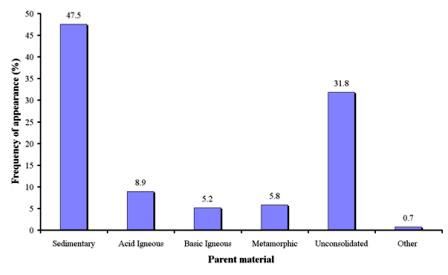Parent material
Parent material is considered as a soil-forming factor affecting soil properties, plant growth, soil erosion and ecosystem resilience. Residual soils have specific physical and chemical characteristics closely related to the parent material. For example soils formed on limestone are usually moderately fine- to fine-textured, slow permeable, with neutral to high pH, high base saturation and high nutrient status. However, carbonate enriched soils may induce minor element deficiencies to sensitive plants. On the contrary, soils formed on acid igneous are usually medium-textured, highly permeable, low pH, low base saturation, and low nutrient status.
Areas with soils formed on different types of parent materials exhibit various degrees of sensitivity to land degradation and desertification. For example, limestone produces shallow soils with a relatively dry moisture regime characterized by moderate erodibility and slow vegetation recovery (Fig. 17). Many areas with soils formed on limestone have been greatly degraded and decertified. Areas with soils formed on shale are normally characterized by high productivity, may supply appreciable amounts of previously stored water to the stressed plants protecting areas from desertification. On the other hand, soils formed on marl, despite their considerable depth and high productivity in normal and wet years, they are very susceptible to desertification, unable to support any annual vegetation in particularly dry years due to adverse soil physical properties. They also frequently form surface crust inhibiting water infiltration and increasing surface runoff.


Fig. 17. Areas under the same climatic conditions with soils formed on shale (left) and limestone (right) subjected to different degree of desertification
Parent material has been classified in this study based on existing systems of classification. The various types of parent materials prevailing in the study sites were grouped into the following classes according to their petrology and mineralogical composition:
| Major class | Group | Type |
| Igneous rock | acid igneous | granite, grano-diorite, quartz-diorite, rhyolite pyroclastics |
| basic igneous | gabbro, basalt, dolerite | |
| ultrabasic igneous | peridotite, pyroxenite, ironstone, serpentine | |
| Metamorphic rock | acid metamorphic | quartzite, gneiss |
| slate, phyllite | ||
| basic metamorphic | schist, gneiss rich in ferro-magnesian, | |
| marble | ||
| Sedimentary rock | clastic sediments | conglomerate, |
| sandstone, | ||
| siltstone, mudstone, claystone, shale | ||
| limestone | ||
| marl | ||
| Unconsolidated | fluvial | |
| lacustrine | ||
| marine | ||
| colluvial |
As Table 3 shows 1492 study field sites were described, corresponding to 15 study sites. The prevailing parent materials are sedimentary rocks such as limestones, marl, and conglomerates in 47.5% of the study sites (Fig 18). Sedimentary materials were found in all study sites except for Secano Interior-Chile, Nestos Basin Maggana-Greece, and Loess Plateau-China study sites. The next important parent material is unconsolidated deposits consisting mainly of alluvial deposits covering 31.8% of the study field sites. Such types of parent material have been found in all study field sites of Nestos Basin Maggana-Greece, and Loess Plateau-China, and in some cases in the other study sites except for Djanybek-Russia, Boteti Area-Botswana, and Konya Karapinar Plain-Turkey. Acid igneous, basic igneous and metamorphic parent materials were found in few cases with frequency of appearance 8.9%, 5.2% and 5.8%, respectively. Such soil parent material have been mainly found in the study sites of Djanybek-Russia, Novij Saratov-Russia, Santiago Island-Cape Verde, Eskisehir Plain-Turkey, Secano Interior-Chile, Cointzio catchment-Mexico, and Rendina Basin Basilicata-Italy.

Fig. 18 Distribution of soil parent material prevailing in the study field sites